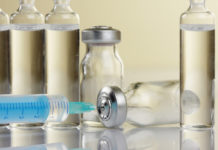Hydrogen peroxide (H2O2) is one of the most used and most advantageous substance to bio decontaminate clean room, insulators, equipment and medical products. This technique is among the favourite in the pharmaceutical sector instead ifother substances widely used but recognised as dangerous for human health (fumigation with formaldehyde, peracetic acid, chlorine dioxide, ozone).
Hydrogen peroxide
Hydrogen peroxide is a strong oxidant with a high antimicrobial power both against a large amount of bacteria and bacterial spores, notoriously the most resistant to biodecontamination.
History
Its introduction dates back to the late ’80s associated with the innovative Gas Plasma technique, applicable above all to the sterilization of surgical products and Medical Devices, although with precise limitations due to incompatibility with some common packaging materials. In the last decade, techniques that exploit the biodecontaminating power of H2O2 vapors have been developed and established.
Vaporized hydrogen peroxide (VPHP)
The vapor-Phase Hydrogen Peroxide (VPHP) is present in different forms and registered by the Environmental Protection Agency (EPA) as a sterilizing agent.
Dry VPHP: water vapor / peroxide (35%) is generated in flash, not necessarily near the sterilization zone, at a concentration that is kept below the one corresponding to the dew point, simply transported in the ducts. The good internal diffusion of the steam and the absence of condensation that reduce the aggressiveness on the materials, are balanced by a longer cycle and a dehumidifying pre-treatment.
Wet VPHP: the steam is generated and fed into the micro condensed phase under conditions of over-saturation of the air. Therefore, to avoid condensation in the ventilation circuits, it is preferable to generate it in the vicinity. The absence of dehumidification phase and a higher sterilization speed are balanced by a greater difficulty in achieving uniform distribution and a longer aeration and washing phase.
HVAC system
An innovative alternative to the clean room bio decontamination of clean rooms, whether they are complex departments or isolated rooms, involves the close integration between the hydrogen peroxide generator and the air conditioning system of the area to be treated. Thanks to the use of a well-functioning HVAC system (Heating, Ventilation and Air Conditioning, necessary for the control of pharmaceutical production processes) it is possible to have a homogeneous distribution of H2O2 throughout the area to be treated. This is possible without the installation of auxiliary fans in the environment. This technique, using air as a diffusion vector, can also be used for the sterilization of absolute filters inside biological safety hoods and ducts present in the areas to be treated. It is a versatile method that can be used for the treatment of pass-boxes, biological safety hoods, insulators and clean rooms with both small and large volumes. Furthermore, it is possible to carry out the biodecontamination treatment of defined spaces in the areas for filling and closing containers for sterile liquids or products that require an aseptic environment.





